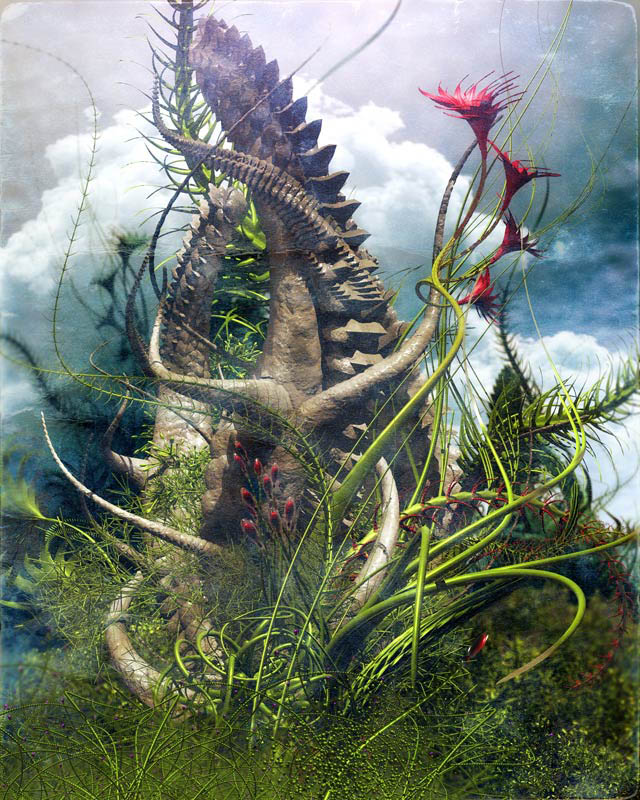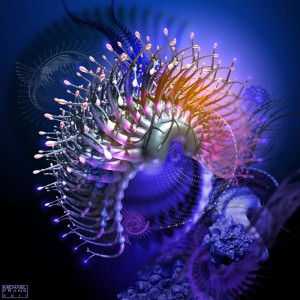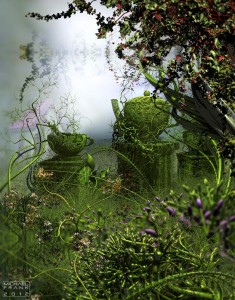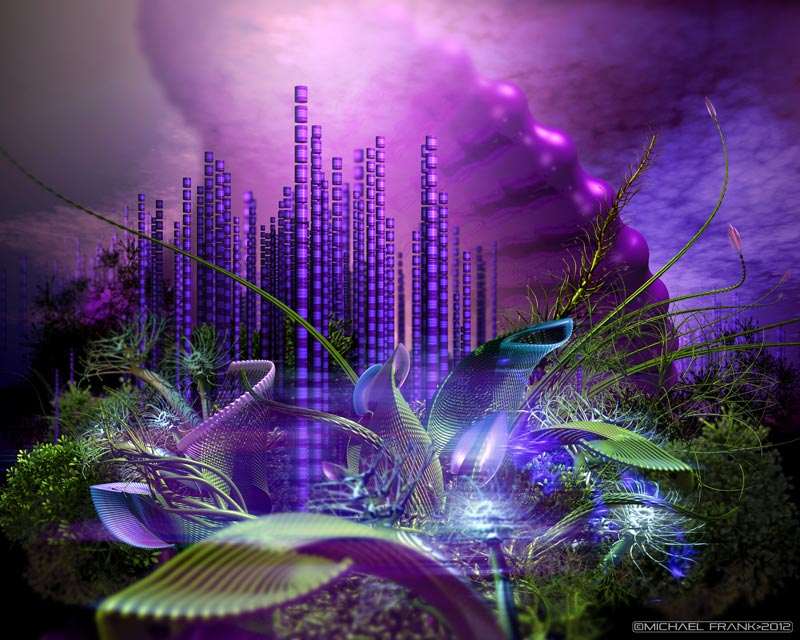One cannot fail to be struck with some measure of awe by Michael Frank’s impeccably arranged and ambitious organic wonders. Surreal and other worldly landscapes and creatures loom out of his dreams to tantalise us with their digitised tendrils, enticing us to pause a moment or a minute or longer… maybe much longer, and ponder. Michael’s images speak of futures and realities and overlapping spaces where anachronisms meet with the timeless to exchange notes. His work is undoubtedly one of the most vivid examples that Bryce can be a tool for the creation of beautiful fine arts of the highest quality. It was an honour and a privilege to correspond with and bug Michael Frank for his thoughts on Bryce and how he uses it.
JW: How long have you been a Bryce user and what is it about Bryce that drew you in the first place?
MF: I’ve been a Bryce user for about three years. I’d known about Bryce for many years, but it wasn’t until I’d bought a new computer and upgraded my systems that I’d remembered I wanted to try it out. The price was right and I stumbled across it at a time when I was beginning to produce more of my personal projects. Bryce offered an easy way of acquainting me with the rudiments of the 3D sensibility. Objects and environments can be created in one seamless effort, all in one program. I found it to be an excellent introduction to the world of 3D art-making.
JW: As someone who obviously isn’t scared to explore new tools, what is it about Bryce that keeps you coming back?
MF: I find Bryce to be special among my preferred software choices, primarily because it was my first 3D software and it’s also a relatively easy program to learn. There are many programs now available that offer a breathtaking array of sophisticated functions, but there are some functions native to Bryce that I can’t get anywhere else, such as the multi replicate tool. Much of my work centers on the natural development of organic forms in Nature, and Bryce is the perfect tool for me to explore these ideas. Additionally, I’m attracted to the ability of Bryce to give me the opportunity to render a whole scene with great ease. It’s a great program for building continuity… earth and sky meet in a smooth unity, whether natural or alien.
JW: Do you think using Bryce as one of your primary tool has influenced your art?
MF: My art wouldn’t have developed along current lines without my discovery of Bryce. It provided a perfect way for me to experiment; I found it an amazing way to explore new ideas, especially in a 3D format. At the time I began making 3D art I was experiencing a high incidence of lucid dreams, a phenomenon allowing an individual to experience waking consciousness within the dream state. My art was an attempt to recreate some of that emotion and experience… a kind of record or logbook. The dreams were extremely dimensional, like experiencing a heightened sense of space and color. 3D programs helped me to simulate that environment and to make (for myself, at least) what I considered to be meaningful art.
JW: I just saw the animation, “Microscopic Entities” up on your YouTube account and really dug the sense of scale and alienness of that minuscule world. What is Bryce like to animate with, and is it something you would like to explore further?
MF: Bryce is a great tool for animation, if you’re an artist with great patience. It’s a painstaking process, but one with great rewards. I learned a great deal while making that movie… how to think more critically about how objects move in space and time. Each frame must be rendered fully, and the more complex the render, the longer it takes! I learned a lot about economizing and simplifying… cutting the right corners without making large sacrifices. I’d urge any Bryce user to explore the possibility of making a movie; an artist is a director of his or her own image and style… but in making a movie, you are even more so a director, as there are much more choices to make. In return, this new responsibility improves your ability as a still-image creator, breathing new skill and possibility into your original skill-set.
JW: Given the chance, what are some of the things you would change about or add to Bryce?
MF: Unfortunately, Bryce is no longer in development, so this question is one of wishful thinking. The first thing I’d change, practically, is that it would continue to be compatible with advancing software systems, primarily Mac. I’ve deliberately hesitated to upgrade my Mac operating system in order to keep working with Bryce as long as it’s convenient for me.
JW: There seems to be some hope that development might continue. I know the question about hypothetical (maybe wishful), but I would still very much like to hear your thoughts on the matter.
MF: I agree that Bryce may have a glimmer of hope for further development, but it’s still highly speculative. If you read the forums or get lucky enough to speak directly to “those in the know,” you’ll notice a considerable amount of frustration on the part of Mac users, coupled with a definite lack of evidence about Bryce’s future. In the 2 years it’s lain dormant, DAZ has amped up their promotion of other products, which clearly appear to be doing brisk business. The DAZ administration hasn’t confirmed even once that a plan exists or even may exist, to save Bryce.
My wish would be that the program were ideally updated. The only concrete evidence that we have right now is that it’s no longer in development, and [still] incompatible with Mac users on current systems. This has been the case for 2 years. In my estimation, Bryce would have to be finally compatible with a great many advancing programs, and Artmatic/Voyager is quite compatible with Mac users already. I will, however, be first in line for the updated program!
JW: What are the advantages of Bryce, other than price? Would you suggest it to artists new to 3D? Would you suggest to more advanced users?
MF: Bryce is occasionally offered by DAZ as a free program, or at a very low price; this is indeed an attractive point. Bryce is a relatively easy program to learn… I found myself using it well without much need to turn to documentation. Even though I call it “easy,” I think that there’s no end to the complex things you can do with it, given time and determination. Bryce is valuable in the hands of beginners and experts alike. I’ve said that the multi-replicate tool is a priceless feature to me, but so too are the opportunities for experimenting with complex lighting and materials.
I’d easily recommend this program to new users, but with the knowledge or warning beforehand that Mac users will be unable to use it on current systems. Although I’d suggest this program to advanced users, it should probably be noted that an “advanced” user has already been exposed to and apprised of other programs that may have a great deal more to offer in terms of sophistication. I view Bryce as a great program that has a place in the history of 3D development, but without routine updating, it’s going to increasingly become a thing of the past.
JW: Why do you think Bryce, in general, is an undervalued program in the 3D community?
MF: In a way I’ve already touched on this, regarding the stall in its development. There are now many programs that perform stunning functions or render with greater speed and ease. I’m not here to promote one program over another, but there are many things available that outperform Bryce, to put it bluntly. The render engine in Bryce can be slow and cumbersome, especially with complex materials. I can’t afford to wait for 100 hours anymore, to render a delicate transparent scene with 6 light sources. I now need the controls and options that larger more sophisticated programs offer.
JW: How do you feel about the future of Bryce, and do you see yourself using it into the future?
MF: Bryce has a future in the hands of devotees who are still probing the possibilities of this remarkable piece of software. Even now it frequently offers up little jewels of discovery… it can still be mined for new resources. There’s a great challenge in rendering beautiful scenes in a single pass, to see just how far it can be pushed, or to see how materials and lighting can be tweaked. I’m one of the artists who are still mesmerized by it, and as long as I have the opportunity, I will keep working with it.
JW: Are you considering taking up other similar tools? Why/why not?
MF: I’ve been experimenting with many new programs. It’s a necessity for any serious artist to stay current and competitive, especially in the industry. These days I can’t do everything with just one or two programs. Many artists toggle easily between several programs, utilizing the best that each has to offer. I’d like to leave the reader with an important point; no software, no matter how sophisticated or user-friendly is going to replace the need and importance for good original ideas and basic skills, like drawing, color theory and composition.
The internet is saturated with the art and offerings of a multitude of creators of varying ability; it doesn’t take much to notice that the successful artists are the ones with great ideas and overall skills. If you can’t draw and paint an apple, it isn’t necessarily going to be easier for you in 3D. I’ve generally found that critics of any software program – particularly 3D ones – are usually the ones who haven’t taken the time to properly learn it. They’re also people who may not have an aptitude in the first place for dimensional reasoning. This quality can be innate or developed, but without that understanding the world of 3D art creation will be a challenge. These programs don’t eliminate the need for solid skills. First and foremost, my art has to do with my message and concept. My tools come second. Bryce has helped bring some of those ideas to life in a unique way, a way in which I’m always grateful.
JW: How much of your work is Bryce, and how much of it is other applications like Photoshop?
MF: In the beginning of my experimentation, my 3D work was done exclusively in Bryce.
I do use Photoshop, and with increasing incidence, Zbrush. I never use ready-made figures or models; I make everything myself. All of my images incorporate Bryce as the main agent. I’ve had critics argue that somehow I’m not much of a purist, but those critics have been completely unable to tell which of my images are raw renders [who needs purists anyway? – JW]. I remind them that over a third of my images are raw renders, and even Bryce allows for image masking and the importation of 2D information… much of which is curiously overlooked by people debating the issue of purism. Some of those processes, simple as they are, can be quite tedious to manage.
Some people may ask: how is it possible to use 40,000 models in a single image? There are many different ways to instance or multi-replicate. I’ve built up a vast library of models in Bryce. Some are used once, some many times indeed. You can even have DAZ running in the background, and import from it into Bryce. I will sometimes do a lot of postwork in Photoshop, but 95% of my work is a Bryce product.
Anybody who thinks that assembling objects in Photoshop is a short-cut should try it with 40,000 objects and then maybe they’d change their tune! Whether rendering raw or composing in Photoshop, my images are potentially a compositional nightmare. I may have a large library, but my scenes are literally built one blade of grass at a time. This is why I urge the viewer to consider what goes into an image beyond the scope of the software… draughtsmanship, color theory, design and above all, the concept and motivation. I’ve spent years studying botany and biology, art history, painting and photography.
I’m a photographer by trade, so when I sit at my computer and manipulate virtual lighting, it’s with the awareness and understanding that comes from my work on a real set, in the studio. It is quite possible to use advanced tools as a crutch, forgetting the importance of basics. Frequently I revert back to pencil and paper in order to keep my drawing skills honed. I do a lot of research as well, on the subjects that are relevant to me. My imagery isn’t accidental or random, but grows out of a constant internal monolog of reasoning… and fantasy. I mix and blend my sensibilities as I mix and blend my software. The final result, I hope, is a fresh new vista of my mind for the viewer, faithful and vital even in its artificiality. In my art, I give the viewer a lot to look at, and I hope by doing so, that there’s a lot to think about as well.
More thoughts on the Bryce workflow, shortcomings, workarounds, and the probablE future slide into software extinction
I don’t use all the functions, nor is it even necessary to use every function in order to produce great art with the system. My models are so complex that I can’t use advanced lighting or materials. I need to cut several corners in order to produce my work. That’s fine, as long as I’m satisfied with the results. I’m constantly questioned by individuals to reveal my secrets or produce directions and tutorials. Most of these people don’t realize that I’m taking the simplest route possible, or using only the most basic of functions that Bryce has to offer.
I suppose it’d be nice to wish for Bryce to do all the things I want it to, more easily… rendering faster, instancing whole models, etc. But I’ve also encountered programs that dramatically outperform Bryce, and do these actual things, so it goes back to my original point that Bryce is becoming an antiquated tool. Why would I take 80 hours to produce a subsurface scattering effect in Bryce when I can render the same thing in 3 minutes in Zbrush? Not only is there the challenge of merely making Bryce compatible for Mac users, but there is also the insurmountable challenge of making the program compatible with the current state of 3D art-making. Two years of slumber hasn’t helped much to encourage the public that a comeback is possible, especially with so many other jewels on the horizon.
I may sound pessimistic, but at the same time, Bryce remains one of my favorite programs, which I highly rate for its ease of use, and the results I get from it. I’d like to keep using it as long as I can.
Michael Frank’s 3D art has been collected and published in several books available from Blurb. Among severl other sites his work can be purchased at BLUECANVAS.
Next in the Bryce Artist Feature series: HDR expert, lens master and all-round experimenter, Horo. He is also another long-time Bryce beta tester and Steering Committee member.










